5.5 Solving Equations Involving Exponential Functions
In this section we will develop techniques for solving equations involving exponential functions. Consider the equation [latex]2^{x} = 128[/latex]. After a moment’s calculation, we find [latex]128 = 2^{7}[/latex], so we have [latex]2^{x} = 2^{7}[/latex]. The one-to-one property of exponential functions, detailed in Theorem 5.7, tells us that [latex]2^{x} = 2^{7}[/latex] if and only if [latex]x=7[/latex]. This means that not only is [latex]x=7[/latex] a solution to [latex]2^{x} = 2^{7}[/latex], it is the only solution.
Now suppose we change the problem ever so slightly to [latex]2^{x} = 129[/latex]. We could use one of the inverse properties of exponentials and logarithms listed in Theorem 5.6 to write [latex]129 = 2^{\log_{2}(129)}[/latex]. We’d then have [latex]2^{x} = 2^{\log_{2}(129)}[/latex], which means our solution is [latex]x = \log_{2}(129)[/latex].
After all, the definition of [latex]\log_{2}(129)[/latex] is the exponent we put on 2 to get 129. Indeed we could have obtained this solution directly by rewriting the equation [latex]2^{x} = 129[/latex] in its logarithmic form [latex]\log_{2}(129) = x[/latex]. Either way, in order to get a reasonable decimal approximation to this number, we’d use the change of base formula, Theorem 5.9, to give us something more calculator friendly. Typically this means we convert our answer to base 10 or base [latex]e[/latex], and we choose the latter: [latex]\log_{2}(129) = \dfrac{\ln(129)}{\ln(2)} \approx 7.011[/latex].
Still another way to obtain this answer is to take/apply the natural log of both sides of the equation. Due to the fact that [latex]f(x) = \ln(x)[/latex] is a function, as long as two quantities are equal, their natural logs are equal.[1]
We then use the Power Rule to write the exponent [latex]x[/latex] as a factor then divide both sides by the constant [latex]\ln(2)[/latex] to obtain our answer.[2]
\[ \begin{array}{rclr}
2^{x} & = & 129 & \\
\ln\left(2^{x}\right) & = & \ln(129) & \text{Take the natural log of both sides.} \\
x \ln(2) & = & \ln(129) & \text{Power Rule} \\ & & &\\
x & = &\dfrac{\ln(129)}{\ln(2)} & \\
\end{array}\]
We summarize our two strategies for solving equations featuring exponential functions below.
Steps for Solving an Equation Involving Exponential Functions
- Isolate the exponential function.
- (a) If convenient, express both sides with a common base and equate the exponents.
(b) Otherwise, take the natural log of both sides of the equation and use the Power Rule.
Example 5.5.1
Example 5.5.1.1
Solve the following equation. Check your answer using a graphing utility.
[latex]2^{3x} = 16^{1-x}[/latex]
Solution:
Solve [latex]2^{3x} = 16^{1-x}[/latex] for [latex]x[/latex].
16 is a power of 2, so we can rewrite [latex]2^{3x} = 16^{1-x}[/latex] as [latex]2^{3x} = \left(2^4\right)^{1-x}[/latex]. Using properties of exponents, we get [latex]2^{3x} = 2^{4(1-x)}[/latex].
Using the one-to-one property of exponential functions, we get
\[ \begin{array}{rcl} 3x & = & 4(1-x) \\
3x & = & 4 – 4x \\
7x & = & 4 \\ & & \\
x & = & \dfrac{4}{7}
\end{array} \]
Graphing [latex]f(x) = 2^{3x}[/latex] (in red) and [latex]g(x) = 16^{1-x}[/latex] (in blue) and see that they intersect at [latex]x =\dfrac{4}{7} \approx 0.571[/latex].
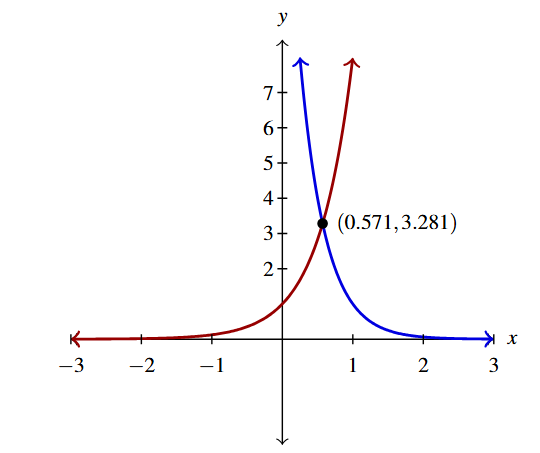
Example 5.5.1.2
Solve the following equation. Check your answer using a graphing utility.
[latex]2000 = 1000 \cdot 3^{-0.1 t}[/latex]
Solution:
Solve [latex]2000 = 1000 \cdot 3^{-0.1 t}[/latex] for [latex]t[/latex].
We begin solving [latex]2000 = 1000 \cdot 3^{-0.1 t}[/latex] by dividing both sides by 1000 to isolate the exponential which yields [latex]3^{-0.1t} = 2[/latex].
As it is inconvenient to write 2 as a power of 3, we use the natural log to get
\[ \begin{array}{rclr} \ln\left(3^{-0.1t}\right) & = & \ln(2) & \\
-0.1 t \ln(3) & = & \ln(2) & \text{Power Rule} \\ & & & \\
t & = & -\dfrac{\ln(2)}{0.1 \ln(3)} & \\ & & & \\
& = & -\dfrac{10\ln(2)}{\ln(3)}
\end{array} \]
We see the graphs of [latex]f(t) = 2000[/latex] (in red) and [latex]g(t) = 1000 \cdot 3^{-0.1 t}[/latex] (in blue) intersect at [latex]t = -\frac{10\ln(2)}{\ln(3)} \approx -6.309[/latex].
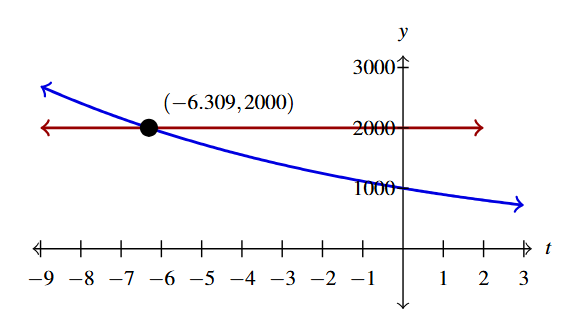
Example 5.5.1.3
Solve the following equation. Check your answer using a graphing utility.
[latex]9 \cdot 3^{x} = 7^{2x}[/latex]
Solution:
Solve [latex]9 \cdot 3^{x} = 7^{2x}[/latex] for [latex]x[/latex].
We first note that we can rewrite the equation [latex]9 \cdot 3^{x} = 7^{2x}[/latex] as [latex]3^2 \cdot 3^x = 7^{2x}[/latex] to obtain [latex]3^{x+2} = 7^{2x}[/latex].
As it is not convenient to express both sides as a power of 3 (or 7 for that matter) we use the natural log: [latex]\ln\left(3^{x+2}\right) = \ln\left(7^{2x}\right)[/latex].
The power rule gives [latex](x+2) \ln(3) = 2x \ln(7)[/latex]. Even though this equation appears very complicated, keep in mind that [latex]\ln(3)[/latex] and [latex]\ln(7)[/latex] are just constants.
The equation [latex](x+2) \ln(3) = 2x \ln(7)[/latex] is actually a linear equation (do you see why?) and as such we gather all of the terms with [latex]x[/latex] on one side, and the constants on the other. We then divide both sides by the coefficient of [latex]x[/latex], which we obtain by factoring.
\[ \begin{array}{rclr}
(x+2) \ln(3) & = & 2x \ln(7) & \\
x \ln(3) + 2 \ln(3) & = & 2x \ln(7) & \\
2 \ln(3) & = & 2x \ln(7) – x \ln(3) & \\
2 \ln(3) & = & x (2 \ln(7) – \ln(3)) & \text{Factor}\\ & & & \\
x & = & \dfrac{2 \ln(3)}{2\ln(7) – \ln(3)} & \\
\end{array}\]
We see the graphs of [latex]f(x) = 9 \cdot 3^{x}[/latex] (in red) and [latex]g(x) = 7^{2x}[/latex] (in blue) intersect at [latex]x = \dfrac{2 \ln(3)}{2\ln(7) - \ln(3)} \approx 0.787[/latex].
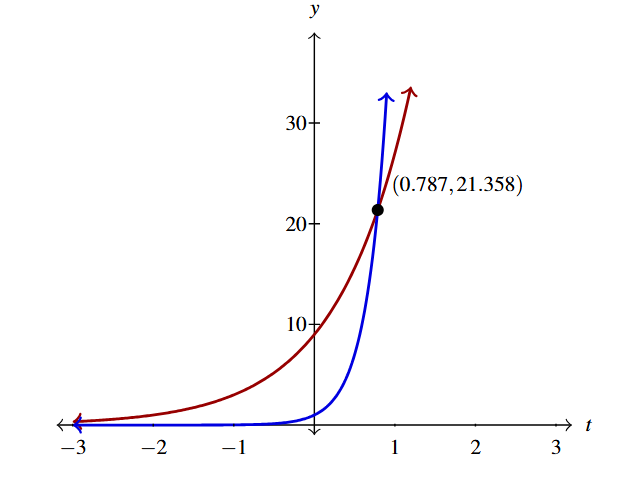
Example 5.5.1.4
Solve the following equation. Check your answer using a graphing utility.
[latex]75 = \dfrac{100}{1 + 3e^{-2t}}[/latex]
Solution:
Solve [latex]75 = \dfrac{100}{1 + 3e^{-2t}}[/latex] for [latex]t[/latex].
Our objective in solving [latex]75 = \dfrac{100}{1 + 3e^{-2t}}[/latex] is to first isolate the exponential.
To that end, we clear denominators and get [latex]75\left(1 + 3e^{-2t}\right) = 100[/latex], or
\[ \begin{array}{rclr} 75 + 225e^{-2t} & = & 100 & \\
225e^{-2t} & = & 25 & \\ & & & \\
e^{-2t} & = & \dfrac{1}{9} & \\ & & & \\
\ln\left(e^{-2t}\right) & = & \ln\left( \dfrac{1}{9} \right) & \text{Apply the natural log} \\ & & & \\
-2t & = & -\ln(9) & \text{Power Rule} \\
t & = & \dfrac{\ln(9)}{2} & \\ & & & \\
t & = & \ln(3) & \end{array} \]
To check, we see the graphs of [latex]f(t) = 75[/latex] (in red) and [latex]g(t) = \dfrac{100}{1 + 3e^{-2t}}[/latex] (in blue), intersect at [latex]t =\ln(3) \approx 1.099[/latex].
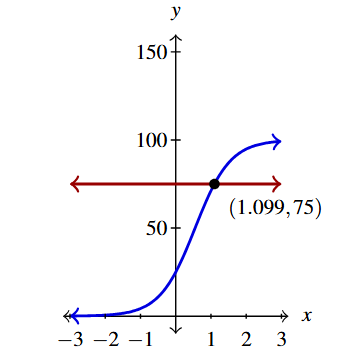
Example 5.5.1.5
Solve the following equation. Check your answer using a graphing utility.
[latex]25^{x} = 5^{x} + 6[/latex]
Solution:
Solve [latex]25^{x} = 5^{x} + 6[/latex] for [latex]x[/latex].
We start solving [latex]25^{x} = 5^{x} + 6[/latex] by rewriting [latex]25 = 5^2[/latex] so that we have [latex]\left(5^2\right)^{x} = 5^{x} + 6[/latex], or [latex]5^{2x} = 5^{x} + 6[/latex].
Even though we have a common base, having two terms on the right hand side of the equation foils our plan of equating exponents or taking logs.
If we stare at this long enough, we notice that we have three terms with the exponent on one term exactly twice that of another. To our surprise and delight, we have a quadratic in disguise.
Letting [latex]u = 5^{x}[/latex], we have [latex]u^2 = \left(5^{x}\right)^2 = 5^{2x}[/latex] so the equation [latex]5^{2x} = 5^{x} + 6[/latex] becomes [latex]u^2 = u + 6[/latex]. Solving this as [latex]u^2 - u - 6=0[/latex] gives [latex]u = -2[/latex] or [latex]u = 3[/latex]. As [latex]u = 5^{x}[/latex], we have \[5^{x} = -2 \text{ or } 5^{x} = 3 \]
[latex]5^{x} = -2[/latex] has no real solution,[3] so we focus on [latex]5^{x} = 3[/latex]. It isn’t convenient to express 3 as a power of 5, thus we take natural logs and get [latex]\ln\left(5^{x}\right) = \ln(3)[/latex] so that \[x \ln(5) = \ln(3) \text{ or } x = \dfrac{\ln(3)}{\ln(5)}\]
We see the graphs of [latex]f(x) = 25^{x}[/latex] (in red) and [latex]g(x) = 5^{x} + 6[/latex] (in blue) intersect at [latex]x = \dfrac{\ln(3)}{\ln(5)}[/latex].
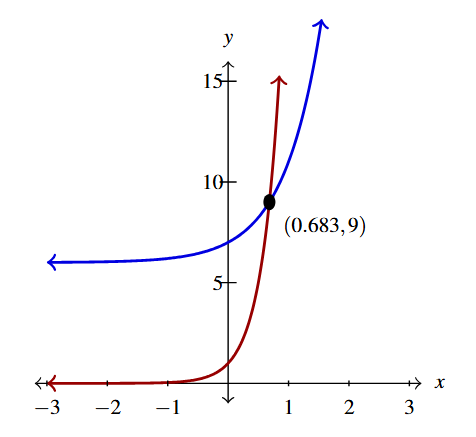
Example 5.5.1.6
Solve the following equation. Check your answer using a graphing utility.
[latex]\dfrac{e^{x} - e^{-x}}{2} = 5[/latex]
Solution:
Solve [latex]\dfrac{e^{x} - e^{-x}}{2} = 5[/latex] for [latex]x[/latex].
Clearing the denominator in [latex]\dfrac{e^{x} - e^{-x}}{2} = 5[/latex] gives [latex]e^{x} - e^{-x} = 10[/latex], at which point we pause to consider how to proceed. Rewriting [latex]e^{-x} = \dfrac{1}{e^{x}}[/latex], we see we have another denominator to clear: [latex]e^{x} - \dfrac{1}{e^{x}} = 10[/latex].
Doing so gives [latex]e^{2x} - 1 = 10e^{x}[/latex], which, once again fits the criteria of being a quadratic in disguise.
If we let [latex]u = e^{x}[/latex], then [latex]u^2 = e^{2x}[/latex] so the equation [latex]e^{2x} - 1 = 10e^{x}[/latex] can be viewed as [latex]u^2-1 = 10u[/latex]. Solving [latex]u^2 - 10u - 1 = 0[/latex] using the quadratic formula gives [latex]u = 5 \pm \sqrt{26}[/latex].
From this, we have [latex]e^{x} = 5 \pm \sqrt{26}[/latex]. Because [latex]5 - \sqrt{26}[/latex] < 0, we get no real solution to [latex]e^{x} = 5 - \sqrt{26}[/latex] (why not?) but for [latex]e^{x} = 5 + \sqrt{26}[/latex], we take natural logs to obtain [latex]x = \ln\left(5 + \sqrt{26}\right)[/latex].
We see the graphs of [latex]f(x) = \dfrac{e^{x} - e^{-x}}{2}[/latex] (in red) and [latex]g(x) = 5[/latex] (in blue) intersect at [latex]x = \ln\left(5 + \sqrt{26}\right) \approx 2.312[/latex].
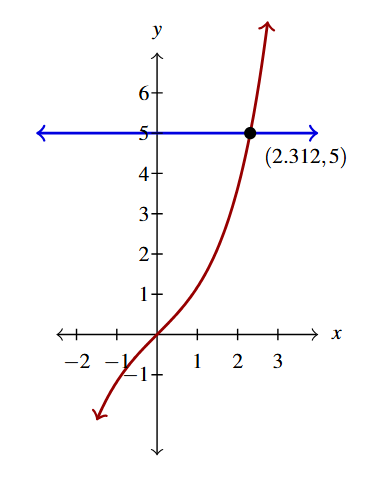
Note that verifying our solutions to the equations in Example 5.5.1 analytically holds great educational value, as it reviews many of the properties of logarithms and exponents in tandem.
For example, to verify our solution to [latex]2000 = 1000 \cdot 3^{-0.1 t}[/latex], we substitute [latex]t = -\dfrac{10\ln(2)}{\ln(3)}[/latex] and check:
\[ \begin{array}{rclr}
2000 & \stackrel{?}{=} & 1000 \cdot 3^{-0.1 \left(-\dfrac{10\ln(2)}{\ln(3)}\right)} & \\
2000 & \stackrel{?}{=} & 1000 \cdot 3^{\dfrac{\ln(2)}{\ln(3)}} & \\
2000 & \stackrel{?}{=} & 1000 \cdot 3^{\log_{3}(2)} & \text{Change of Base}\\
2000 & \stackrel{?}{=} & 1000 \cdot 2 & \text{Inverse Property}\\
2000 & \stackrel{\checkmark}{=} & 2000 & \\
\end{array}\]
We strongly encourage the reader to check the remaining equations analytically as well.
We close this section by finding a function inverse.
Example 5.5.2
Example 5.5.2.1
The function [latex]f(x) = \dfrac{5e^{x}}{e^{x}+1}[/latex] is one-to-one.
Write a formula for [latex]f^{-1}(x)[/latex].
Solution:
Write a formula for [latex]f^{-1}(x)[/latex].
We start by writing [latex]y=f(x)[/latex], and interchange the roles of [latex]x[/latex] and [latex]y[/latex]. To solve for [latex]y[/latex], we first clear denominators and then isolate the exponential function.
\[ \begin{array}{rclr}
y & = & \dfrac{5e^{x}}{e^{x}+1} & \\ & & & \\
x & = & \dfrac{5e^{y}}{e^{y}+1} & \text{Switch } x \text{ and } y \\ & & & \\
x \left(e^{y}+1\right) & = & 5e^{y} & \\ & & & \\
x e^{y}+x & = & 5e^{y} & \\ & & & \\
x & = & 5e^{y} – x e^{y} & \\ & & & \\
x & = & e^{y}(5 – x) & \\ & & & \\
e^{y}& = & \dfrac{x}{5-x} & \\ & & & \\
\ln\left(e^{y}\right) & = & \ln\left(\dfrac{x}{5-x}\right) & \\ & & & \\
y & = & \ln\left(\dfrac{x}{5-x}\right) & \\
\end{array}\]
We claim [latex]f^{-1}(x) = \ln\left(\dfrac{x}{5-x}\right)[/latex]. To verify this analytically, we would need to verify the compositions [latex]\left(f^{-1} \circ f\right)(x) = x[/latex] for all [latex]x[/latex] in the domain of [latex]f[/latex] and that [latex]\left(f \circ f^{-1}\right)(x) = x[/latex] for all [latex]x[/latex] in the domain of [latex]f^{-1}[/latex]. We leave this, as well as a graphical check, to the reader in Exercise 41.
Example 5.5.2.2
The function [latex]f(x) = \dfrac{5e^{x}}{e^{x}+1}[/latex] is one-to-one.
Solve [latex]\dfrac{5e^{x}}{e^{x}+1} = 4[/latex].
Solution:
Solve [latex]\dfrac{5e^{x}}{e^{x}+1} = 4[/latex].
We recognize the equation [latex]\dfrac{5e^{x}}{e^{x}+1} = 4[/latex] as [latex]f(x) = 4[/latex]. Hence, our solution is \[ \begin{array}{rcl} x &=& f^{-1}(4) \\ & & \\ &=& \ln\left(\dfrac{4}{5-4}\right) \\& & \\ &=& \ln(4) \end{array} \]
We can check this fairly quickly algebraically. Using [latex]e^{\ln(4)} = 4[/latex], we find [latex]\dfrac{5e^{\ln(4)}}{e^{\ln(4)}+1} = \dfrac{5(4)}{4+1} = \dfrac{20}{5} = 4[/latex].
5.5.1 Section Exercises
In Exercises 1 – 33, solve the equation analytically.
- [latex]2^{4x} = 8[/latex]
- [latex]3^{(x - 1)} = 27[/latex]
- [latex]5^{2x-1} = 125[/latex]
- [latex]4^{2t} = \dfrac{1}{2}[/latex]
- [latex]8^{t} = \dfrac{1}{128}[/latex]
- [latex]2^{(t^{3} - t)} = 1[/latex]
- [latex]3^{7x} = 81^{4-2x}[/latex]
- [latex]9 \cdot 3^{7x} = \left(\dfrac{1}{9}\right)^{2x}[/latex]
- [latex]3^{2x} = 5[/latex]
- [latex]5^{-t} = 2[/latex]
- [latex]5^{t} = -2[/latex]
- [latex]3^{(t - 1)} = 29[/latex]
- [latex](1.005)^{12x} = 3[/latex]
- [latex]e^{-5730k} = \dfrac{1}{2}[/latex]
- [latex]2000e^{0.1t} = 4000[/latex]
- [latex]500\left(1-e^{2t}\right) = 250[/latex]
- [latex]70 + 90e^{-0.1t} = 75[/latex]
- [latex]30-6e^{-0.1t}=20[/latex]
- [latex]\dfrac{100e^{x}}{e^{x}+2}=50[/latex]
- [latex]\dfrac{5000}{1+2e^{-3t}}=2500[/latex]
- [latex]\dfrac{150}{1 + 29e^{-0.8t}} = 75[/latex]
- [latex]25\left(\dfrac{4}{5}\right)^{x} = 10[/latex]
- [latex]e^{2x} = 2e^{x}[/latex]
- [latex]7e^{2t} = 28e^{-6t}[/latex]
- [latex]3^{(x - 1)} = 2^{x}[/latex]
- [latex]3^{(x - 1)} = \left(\dfrac{1}{2}\right)^{(x + 5)}[/latex]
- [latex]7^{3+7x} = 3^{4-2x}[/latex]
- [latex]e^{2t} - 3e^{t}-10=0[/latex]
- [latex]e^{2t} = e^{t}+6[/latex]
- [latex]4^{t} + 2^{t} = 12[/latex]
- [latex]e^{x}-3e^{-x}=2[/latex]
- [latex]e^{x}+15e^{-x}=8[/latex]
- [latex]3^{x}+25\cdot3^{-x}=10[/latex]
In Exercises 34 – 39, find the domain of the function
- [latex]T(x) = \dfrac{e^{x} - e^{-x}}{e^{x} + e^{-x}}[/latex]
- [latex]C(x) = \dfrac{e^{x} + e^{-x}}{e^{x} - e^{-x}}[/latex]
- [latex]s(t) = \sqrt{e^{2t} - 3}[/latex]
- [latex]c(t) = \sqrt[3]{e^{2t} - 3}[/latex]
- [latex]L(x) = \log\left( 3 - e^{x} \right)[/latex]
- [latex]\ell(x) = \ln\left( \dfrac{e^{2x}}{e^{x}-2} \right)[/latex]
- Compute the inverse of [latex]f(x) = \dfrac{e^{x} - e^{-x}}{2}[/latex]. State the domain and range of both [latex]f[/latex] and [latex]f^{-1}[/latex].
- In Example 5.5.1, we found that the inverse of [latex]f(x) = \dfrac{5e^{x}}{e^{x}+1}[/latex] was [latex]f^{-1}(x) = \ln\left(\dfrac{x}{5-x}\right)[/latex] but we left a few loose ends for you to tie up.
- Algebraically check our answer by verifying: [latex]\left(f^{-1} \circ f\right)(x) = x[/latex] for all [latex]x[/latex] in the domain of [latex]f[/latex] and that [latex]\left(f \circ f^{-1}\right)(x) = x[/latex] for all [latex]x[/latex] in the domain of [latex]f^{-1}[/latex].
- Find the range of [latex]f[/latex] by finding the domain of [latex]f^{-1}[/latex].
- With help of a graphing utility, graph [latex]y = f(x)[/latex], [latex]y = f^{-1}(x)[/latex] and [latex]y = x[/latex] on the same set of axes. How does this help to verify our answer?
- Let [latex]g(x) = \dfrac{5x}{x+1}[/latex] and [latex]h(x) = e^{x}[/latex]. Show that [latex]f = g \circ h[/latex] and that [latex](g \circ h)^{-1} = h^{-1} \circ g^{-1}[/latex].
Section 5.5 Exercise Answers can be found in the Appendix.
- This is also the if part of the statement [latex]\log_{b}(u) = \log_{b}(w)[/latex] if and only if [latex]u=w[/latex] in Theorem 5.7. ↵
- Please resist the temptation to divide both sides by [latex]\ln[/latex] instead of [latex]\ln(2)[/latex]. Just like it wouldn't make sense to divide both sides by the square root symbol [latex]\sqrt{\vphantom{2} \,}[/latex] when solving [latex]x \sqrt{2} = 5[/latex], it makes no sense to divide by the symbol [latex]\ln[/latex]. ↵
- Why not? ↵

